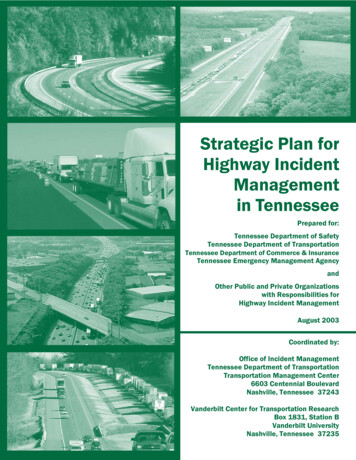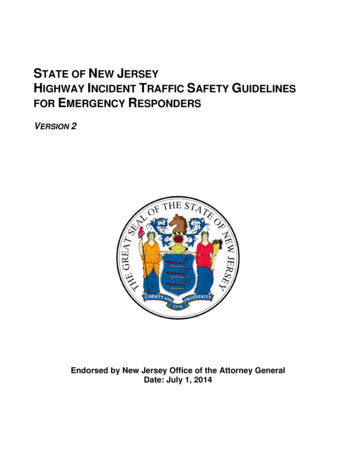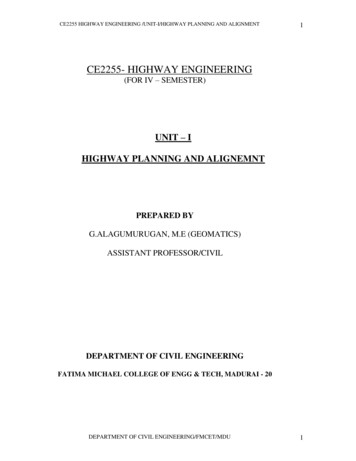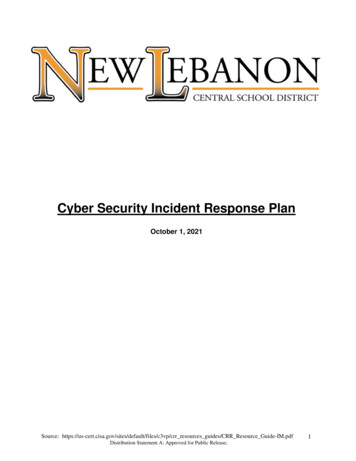
Transcription
Strategic Plan forHighway IncidentManagementin TennesseePrepared for:Tennessee Department of SafetyTennessee Department of TransportationTennessee Department of Commerce & InsuranceTennessee Emergency Management AgencyandOther Public and Private Organizationswith Responsibilities forHighway Incident ManagementAugust 2003Coordinated by:Office of Incident ManagementTennessee Department of TransportationTransportation Management Center6603 Centennial BoulevardNashville, Tennessee 37243Vanderbilt Center for Transportation ResearchBox 1831, Station BVanderbilt UniversityNashville, Tennessee 37235
Strategic Plan for Highway Incident Managementin TennesseePrepared for:Tennessee Department of SafetyTennessee Department of TransportationTennessee Department of Commerce and InsuranceTennessee Emergency Management AgencyandOther Public and Private Organizations withResponsibilities for Highway Incident ManagementCoordinated by:Office of Incident ManagementTennessee Department of TransportationTransportation Management Center6603 Centennial BoulevardNashville, Tennessee 37243and theVanderbilt Center for Transportation ResearchBox 1831, Station BVanderbilt UniversityNashville, Tennessee 37235August 2003
Table of ContentsChapterPageIntroduction. . . 11Components of Highway Incident Management .32Importance of Highway Incident Management for Tennessee. . 113Recent Accomplishments . . 194The Planning Process . 255Strategic Plan and Action Tasks. . 336Implementation . 81Notes . 89Strategic Plan for Highway Incident Management in Tennesseei
List of ExhibitsExhibitiiPage1Critical Components of Effective Highway Incident Management .52Depiction of Highway Incident Management from the Wisconsin TIMEProgram . 83Links Between Highway Incident Management and Other Programs andServices .94Rural Delays . 145Urban Delays . 156Secondary Crash 167Incident Scene 178Advances in Highway Incident Management in Tennessee, 1996-2003. . 209HELP Logo 2210Traffic Control . 2311Organization for Highway Incident Management Planning andCoordination . 2512Responsibilities for Statewide Highway Incident Management Planning andCoordination . 2613Representation on the Policy and Steering Committees 2714Development of the Recommended Strategic Plan and Action Tasks . 28Strategic Plan for Highway Incident Management in Tennessee
List of TablesTablePage1Promote Measures to Reduce the Number and Severity of HighwayIncidents . 352Better Inform and Educate Motorists to Reduce Incident-Related Congestionand Improve Safety. . 383Expand and Enhance Resources for Systematic Management of HighwayIncidents . 424Expand and Enhance Training for Highway Incident Responders 475Support Highway Incident Management Teams in Metropolitan and UrbanAreas . 496Sponsor Highway Incident Management Teams in Rural Areas . 527Accelerate Deployment of New Technologies to Improve IncidentManagement . 558Reduce Traffic Congestion Caused by Highway Work Zones . 609Establish Working Groups to Address Statewide Issues and RecommendActions . 6310Promote Ongoing Interagency Planning and Coordination . 6711Highway Incident Management Strategic Plan, 2003-2008: Action Tasks . 71Strategic Plan for Highway Incident Management in Tennesseeiii
ivStrategic Plan for Highway Incident Management in Tennessee
INTRODUCTIONThe Strategic Plan for Highway Incident Management in Tennessee establishes theframework for a systematic, statewide, multi-agency effort to improve the management ofhighway incidents—crashes, disabled and abandoned vehicles, debris in the roadway, workzones, adverse weather, and other events and emergencies that impact the transportationsystem. The plan is a joint effort by governmental and private organizations that haveresponsibilities for highway incident management and public safety. The plan is part of thefoundation for ongoing planning and coordination.Highway incidents have a significant impact on the capacity and safety of the state’stransportation system and lead to costly travel delays, secondary crashes, hazards for involvedmotorists and incident responders, air pollution, and wasted fuel. These adverse consequencesare examined in more detail later in the report, but the following information highlights thenational importance of highway incident management: Traffic congestion is widely recognized as a serious and growing problem, but the directlink between congestion and highway incidents is sometimes overlooked—more than50 percent of urban traffic congestion is caused by non-recurring incidents ratherthan inadequate capacity. In rural areas, virtually 100 percent of traffic congestionis caused by incidents.1 “Secondary crashes,” following incidents that have not been cleared, cause additionalproperty damage, injuries, and fatalities. Determining the frequency of secondarycrashes on a specific roadway is difficult, but a frequently used national estimate is thatapproximately 20% of all freeway crashes are secondary.2 A California study foundthat each time an accident occurs the potential for another accident increases by atleast 600%.3 Virtually every highway user has first hand experience with incidents—traffic backed upfor miles without explanation, trucks struggling up long grades, cars on the shouldersoverheated or out of gas, motorists switching lanes and driving on the shoulders ormedians to escape the backup, and bumper-to-bumper, stop-and-go traffic that addsmore harmful emissions to the air. Sometimes, the problem is a disabled vehicle, a rearend collision, a ladder in the roadway, or some other minor incident. Other times, theincident involves serious injuries, overturned vehicles, or hazardous materials. Still othertimes, the backup is caused by highway construction or repair. Regardless of the cause,time is wasted, appointments are missed, productivity is lost, and travelersexperience frustration, anger, and road rage.From the traveler’s perspective, the situation is made worse by slow or inadequate measuresto “manage” the incident. The responsibilities for incident management are shared among amultitude of organizations with different, and sometimes conflicting, priorities. The centralthemes of the recommended plan and the ongoing planning process are to make “quickclearance” a shared priority for all incident responders, promote safety for motorists andincident responders, and reduce the direct and indirect costs of highway incidents.Strategic Plan for Highway Incident Management in Tennessee1
Organization of the ReportThe report is divided into six chapters: Chapter 1 provides definitions, a generic list of stakeholders, and an overview of themajor components of highway incident mana gement. Chapter 2 examines the importance of highway incident management for Tennesseein more detail by describing the large number of stakeholders, the frequency andseverity of incidents, and the problems caused by incidents. Chapter 3 highlights recent accomplishments and progress made toward moreeffective highway incident management. Chapter 4 describes the ongoing process for planning and coordination and the stepsthat were followed to develop the strategic plan. Chapter 5 presents the recommended strategic plan, with 10 major goals and morethan 150 action tasks. The final chapter, Chapter 6, offers suggestions for implementation of therecommended plan and discusses costs and possible funding sources.2Strategic Plan for Highway Incident Management in Tennessee
CHAPTER 1COMPONENTS OF HIGHWAY INCIDENT MANAGEMENTWhat do we mean by “highway incidents”? What “incidents” need to be “managed”? Thedefinition used in this report for “highway incident” is any non-recurring event orcircumstance that disrupts the normal flow of traffic or threatens the safety of motorists,residents, or businesses in the vicinity of the highway.Examples of such events or circumstances include all of the following: Motor vehicle crashes (including minor “fender benders” as well as multi- vehiclecollisions involving fatalities, injuries, extensive property damage, or hazardous materials)Disabled or abandoned vehiclesDebris on or near the roadwayWork zones for construction, maintenance, utility, or emergency repair workSpecial events that generate high traffic vo lumes or unusual movementsAdverse weather conditionsOther non-recurring conditions, such as law enforcement activity, smoke from a nearbyfire, pedestrians near the roadway, stray animals, vandalism, flooding, and acts ofterrorism directed against the highway infrastructure or highway users or that createexceptional transportation demands As every motorist knows, any of the situations listed above can quickly lead to trafficbackups, long delays, secondary crashes, and a host of other problems, all exasperated byrubbernecking and unsafe driving.StakeholdersHighway incident management involves a large group of agencies and disciplines, includingall of the following: Law enforcementFire servicesEmergency communication servicesEmergency medical servicesHospitals and trauma centersRescue squadsTowing and recovery operatorsTransportation management centersHazardous material respondersTraffic reporters Strategic Plan for Highway Incident Management in TennesseeHighway and public works agenciesUtility companiesHighway contractorsTransportation planning organizationsTraffic engineersHighway neighborsMotorists/truckersTrucking companies, shippers, insurancecompanies, and other businesses that serveor depend on highway transportation3
All of these stakeholders have different perspectives and priorities and all have importantroles to play in highway incident management. Coordination among all of the stakeholders isone of the primary challenges for strategic planning and for improvement of day-to-dayincident management.Components of Highway Incident ManagementIncident management includes all of the activities undertaken to assist involved motorists,protect public health and safety, conduct necessary investigations, minimize travel disruptionsand delays, remove the damaged vehicles or cargo, and restore the roadway to normalconditions. Effective incident management also requires planning, preparation, and measuresto educate and inform motorists prior to and during incidents.Each incident and each scene is different, but certain steps or phases are common to themanagement of most highway incidents. Improvements in highway incident managementmust recognize these steps and their interrelationships. For this report, the steps involved inhighway incident management are categorized as follows: DetectionVerificationNotification and responseMotorist informationEmergency actionScene management and traffic controlInvestigationScene clearanceTraffic resumptionThese are illustrated in Exhibit 1 and described below.DetectionThe necessary first step in incident management is detection, the process by which one of theresponsible agencies in the network of incident responders is made aware that a problemexists. In the best situations, the incident is detected almost as soon as it occurs, but that is notalways the case. Within a few years incidents will be detected automatically on Tennessee’shighest volume urban freeways through the use of sensors, computers, and other technologies.In the meantime, and for a much longer time on the outlying and rural highways, the systemwill have to depend on information from persons at the scene. Information may enter thesystem from phone calls to the 911 center or other public safety answering points (e.g.,*THP), observation by a public safety officer, HELP operator, or other fleet operator withtwo-way communication, relay of information heard on a citizens band radio, or other indirectsources. Regardless, responses cannot begin until the incident has been detected.4Strategic Plan for Highway Incident Management in Tennessee
Scene management and traffic controlDetectionNotification and responseVerificationEmergency actionInvestigationClearanceMotorist informationTimeScene ClearedIncident OccursTraffic Returns to “Normal”Exhibit 1: Critical Components of Effective Highway Incident ManagementVerificationVerification includes all of the actions taken to confirm the exact location of the incident andto gather as much information as possible about the characteristics of the incident and theincident scene. The goal is to ensure that all responders have the information they need tomobilize and dispatch the proper equipment in a timely manner. Verification begins as soonas possible after incident detection and usually continues at least until the first respondersreach the scene. Verification can be accomplished by combining information from multiplephone calls, viewing the scene or the vicinity with a closed circuit television (CCTV) camera,or by aerial surveillance. The verification process is usually complete after the first respondersreach the scene, but not always. The presence of hazardous materials or unknown substancesmay extend the time required for complete verification, and, of course, circumstances canchange before the incident is brought under control.Notification and responseOnce the incident is detected, and often before verification is complete, the notification andresponse process begins—activating the communication links among responsible agencies,receiving notification that a response is needed, dispatching, mobilizing equipment andpersonnel, selecting access routes, and moving to the scene. Timely notification and orderlyresponse are critical for incident management, recognizing that the verification process maystill be underway and that the responses may have to be modified mid-process. NotificationStrategic Plan for Highway Incident Management in Tennessee5
and response may involve just one or two agencies to handle a simple problem or a largenumber of agencies from multiple jurisdictions to manage a more complex situation. Thecoordination challenges begin as soon as the first responders begin moving to the incidentscene.Motorist informationThe motorist information phase includes gathering and analyzing information about theincident, the incident scene, and possible alternate routes and then disseminating thatinformation to motorists in a timely manner. By using all available outlets (e.g., commercialradio and TV, Web pages, changeable message signs, highway advisory radio), the adversesystem-wide impacts on travel and safety can be minimized along with the traffic problems atthe immediate scene. The motorist information process should begin as soon as the incidenthas been verified, and the process of gathering, analyzing, and disseminating reliable, realtime information should continue until traffic has returned to normal flow, which is often longafter the scene has been cleared.Emergency actionAt some incident scenes, emerge ncy action is necessary, and must begin as soon as the firstresponders reach the scene. Examples include fire fighting, emergency medical treatment,extrication, evacuation, containment of hazardous materials, removal of explosive materials,apprehension of dangerous persons, and any other activities needed to assist injured parties orto eliminate threats to public health or safety. Emergency action must receive priority, butother steps can usually proceed in parallel.Scene management and traffic controlEnsuring the safety of responders and others at the incident scene is the first step in what isoften the most challenging phase of incident management—scene management and trafficcontrol. This involves accurately assessing the situation, establishing priorities, ensuringproper coordination and communication among responders, and allocating resources. Tasks tobe accomplished include staging, positioning and re-positioning of people and equipment,scheduling activities, directing traffic around or through the scene, and managing trafficthroughout the impacted corridor. In many cases, the most dangerous locations may be manymiles away from the incident scene—at the back of the traffic queue. Coordination amongagencies and unified command are essential, and traffic control must be in accordance withapplicable rules and regulations.InvestigationInvestigation encompasses all of the activities and tasks that must be performed at the incidentscene (e.g., measuring and recording distances, taking pictures) to help determine the cause ofthe incident and to serve as a basis for subsequent legal actions or financial settlements. Lawenforcement investigations are not always needed, and, when needed, the extent may varyfrom simple observation and recording of the relative positions of vehicles to extensive6Strategic Plan for Highway Incident Management in Tennessee
collection of information for criminal prosecution. In the best situations, investigators haveclear guidelines for the level of investigative detail needed for each type of incident. Ideally,the investigators also have the technology and training to gather data with minimum impacton traffic. Most other responders also record information about their respective actions, butusually do not need to gather as much information as law enforcement officers.Scene clearanceClearance involves the removal of damaged vehicles, spilled cargo, debris, hazardousmaterials, and any other obstructions to the normal flow of traffic. In some cases, damagedsigns, light poles, or other roadway infrastructure may also have to be removed from the sceneor temporarily repaired. This stage of the incident management process also involves removalof traffic cones, signs, and other temporary traffic control devices used for scene management,the departure of emerge ncy vehicles, and other “demobilization” activities. The hazards forincident responders increase as traffic speeds begin to increase and the presence of emergencyvehicles and workers becomes less apparent.Traffic resumptionAfter the scene is completely clear and the responders have moved on, traffic begins to flowpast the site at a more normal rate, and the traffic backup slowly begins to dissipate.However, hours may pass before the queue has fully dissipated and complete recovery isachieved. Providing accurate information to motorists should continue until traffic hasreturned to normal, and during part of the recovery period traffic control may be needed atlocations far distant from the original scene. The factors that help determine the recovery timeinclude the time of day, roadway capacity and grades, and effectiveness of the motoristinformation phase of incident management, but the single most important factor is theduration of the incident, especially the time that lanes were partially or completely blocked.Reducing the Time Required for Each StepUnder most conditions, blocking a roadway for even a few minutes will cause long termdisruptions in traffic flow. Even a vehicle on the shoulder causes traffic flow problems, not tomention the implications for highway safety. The goal of effective incident management is foreach step in Exhibit 1 to begin as soon as possible and then be completed as soon aspossible—with as many steps as possible carried out in parallel rather than in sequence. Awidely used rule of thumb is: for every minute a lane of traffic is blocked, recovery to normaltraffic flow will require an additional four to five minutes.4 Of course, safety is always anoverriding priority, but quick clearance can be accomplished without compromising safety.Broader ContextTo describe the broader context for highway incident management, two other exhibits areoffered. Exhibit 2, from the Wisconsin TIME (Traffic Incident Management Enhancement)program, is another way of depicting the steps in incident management. This versionrecognizes two additional, very important components for effective incident management.Strategic Plan for Highway Incident Management in Tennessee7
Exhibit 2: Depiction of Highway Incident Management from theWisconsin TIME Program5The first additional component, planning, must be accomplished long before “detection”occurs. Careful planning is necessary to prepare for events that may occur anywhere on thehighway system (e.g., crashes, disabled vehicles, debris in the roadway, localized flooding,emergency work zones) as well as for events that are more predictable or have system- wideimplications (e.g., a large sporting or entertainment event, a long-term construction workzone, or snow and ice).The second important recognition is that evaluation and feedback are needed for effectiveincident management. Incident responders are very aware that “every incident is different.”Rules and clear directions cannot be established in advance of every situation, so continuouslearning and adaptation is required. Debriefings, case studies, performance reports, and otherforms of evaluation and feedback are essential learning tools for individual agencies and forthe collective efforts of all the incident responders. The experience gained at each majorincident should be an integral part of planning and preparation for the next incident.Exhibit 3 illustrates some of the links between highway incident management and otherimportant programs and services provided by state and local governments. Many of theseother programs and services are more comprehensive and far reaching than highway incidentmanagement, but the interrelationships are nonetheless significant. Many of the goals are thesame for highway incident management as for the other illustrated programs and services.Success in one program will facilitate success in another.8Strategic Plan for Highway Incident Management in Tennessee
Resources committed to highway incident management should prove useful to other programsand services. Vehicles and equipment to help manage routine highway incidents should alsobe useful during other emergencies. Likewise, investments to improve the interoperability ofcommunication systems for emergency management and homeland security will have day-to day benefits for highway incident management.Exhibit 3: Links Between Highway Incident Managementand Other Programs and ServicesPlanning and preparation for any one of the identified programs/services will help withplanning and preparation for the others. Many of the tools and techniques for planning andcoordination are interchangeable, and the needed data is virtually the same. For example,planning for all of these programs/services requires information about the base location,capacity, and demands on the transportation infrastructure and the availability oftransportation services. Similarly, having accurate and readily available information about thelocation of incident responders and their respective capabilities and resources is valuable forhighway incident manageme nt, all- hazards emergency management, homeland security, andother programs/services illustrated below.Finally, many of the stakeholders are the same. Effective highway incident managementrequires coordination among transportation and emergency manageme nt organizations, lawenforcement agencies, fire and emergency medical services, highway contractors, truckingcompanies, metropolitan transportation planning organizations, and other federal, state, andlocal agencies. All of those same organizations, and many of the people in those organizationswho work on highway incident management, also work together as part of the other importantprograms and services shown in Exhibit 3.Strategic Plan for Highway Incident Management in Tennessee9
10Strategic Plan for Highway Incident Management in Tennessee
CHAPTER 2IMPORTANCE OF HIGHWAY INCIDENT MANAGEMENTFOR TENNESSEEThis chapter addresses the importance of highway incident management for Tennessee inmore detail, beginning with an inventory of the organizations that share responsibilities forincident management and some indicators of the frequency and severity of incidents. Thechapter ends with data and examples to better describe the adverse consequences of highwayincidents.Tennessee Incident RespondersResponsibilities for highway incident management in Tennessee are shared by a large numberof state, local, and private organizations. The state agencies include all of the following: Department of Safety (including the Tennessee Highway Patrol, CommercialVehicle Enforcement, and the Tennessee Law Enforcement Training Academy) Department of Transportation (including HELP, the Nashville TransportationManagement Center, Headquarters, Region, District, and County offices) Tennessee Emergency Management Agency Department of Commerce and Insurance (including Division of Fire Protection,Tennessee Fire and Codes Training Academy, and the Tennessee EmergencyCommunications Board) Department of Health (including the Emergency Medical Services Division) Office of Homeland Security Department of Finance and Administration (including the Office of CriminalJustice Programs)The local and private sector resources include all of the following: 6 More than 350 police and sheriffs departments Approximately 650 fire services organizations, some with paid firefighters, someentirely volunteer, and some with a combination of paid and volunteer firefighters More than 100 emergency ambulance services with a total of approximately 1,000ambulances and more than a dozen helicopters used for medical emergencies Thirteen designated trauma centers, including six “level one” centers (inChattanooga, Kingsport, Knoxville, Johnson City, Memphis, and Nashville) and 89hospitals with licensed heliportsStrategic Plan for Highway Incident Management in Tennessee11
More than 110 local rescue squads, virtually all volunteer Approximately 1,570 towing and recovery vehicles on the approved call list for theDepartment of Safety (plus an undetermined number of other towing and recoveryvehicles that are approved or licensed by local governments) More than 100 city and county emergency management agencies More than 200 city and county highway and public works agencies Eleven metropolitan transportation planning organizations (MPOs)Finally, state and local agencies in the eight adjacent states are important partners formanagement of incidents that impact traffic on both sides of the respective state lines. Most ofthe state and local agencies that respond to incidents in Tennessee have counterparts inGeorgia, Alabama, Mississippi, Arkansas, Missouri, Kentucky, Virginia, and North Carolina.Frequency and Severity of IncidentsOne of the recommendations presented in Chapter 5 is to establish an integrated informationsystem to keep track of the incidents that occur on Tennessee highways and to measure thetime and resources required to manage those incidents. Currently, agencies record informationabout their own activities, but no comprehensive picture is available to measure the overallfrequency or severity of incidents. However, the following information provides a generalindication: Law enforcement and other public safe ty and emergency services organizations inTennessee respond to more than 170,000 motor vehicle crashes each year, an average ofmore than 460 crashes every day. Approximately 140 of those daily crashes involvepersonal injuries. Three of those daily crashes involve a fatality. 7 A truck overturns on a major highway in Tennessee almost every day. On some days,multiple rollovers occur. Frequently, the cargo spills and fuel leaks onto the roadway. 8 A review of records from the Tennessee Emergency Management Agency (TEMA)Operations Center for the first nine months of 2002 identified 260 reported incidentsthat occurred on or near a federal or state highway. Of the total, more than 100 involvedspilled fuel, oil, or a hazardous material. More than 130 of the 260 entailed closure of atleast one lane of travel. Almost 100 of the incidents led to complete closure of at leastone direction of travel for periods of up to 16 hours.9 TDOT estimates that their field maintenance forces were “called out” at night and onweekends more than 950 times in 2002, not including ice and snow events, to deal withproblems such as rock slides, settlements, local flooding, downed signs, and othersituations that impede traffic or endanger public safety, or to help with traffic controland cleanup following major crashes.10 On an average day in 2002 the HELP operators in the four cities removed debris fromthe roadway more than 20 times, changed more than 30 flat tires, refueled more than 2012Strategic Plan for Highway Incident Management in Tennessee
vehicles, and helped motorists with mechanical problems almost 40 times. They moveddamaged or disabled vehicles from travel lanes 15 times each day, and they “tagged”more than 40 abandoned vehicles. They also jump-started 9 vehicles, transported 5stranded motorists to the nearest exit, and helped secure the loads on 3 vehicles. In anaverage week, they performed first aid 11 times, put absorbent on spilled fuel or oil at11 locations, and extinguished 3 vehicle fires. Each summer in Tennessee, an average of more than 1,100 miles of state and federalhighways have to be resurfaced to maintain a 12-year rehabilitation cycle. During thewinter months, ice and snow conditions affect travel throughout the state. Other times,heavy rain, fog, and high winds cause problems that snarl traffic. Several dozen times each year travel dem
Highway Incident Management in Tennessee Prepared for: Tennessee Department of Safety Tennessee Department of Transportation Tennessee Department of Commerce & Insurance Tennessee Emergency Management Agency and Other Public and Private Organizations with Responsibilities for Highway Incident Management August 2003 Coordinated by:










